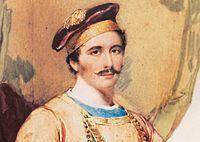Name William Fraser | ||
 | ||
Role British India civil servant Died March 22, 1835, Delhi, New Delhi | ||
William Fraser (1784 – March 22, 1835) was a British India civil servant who was an Agent to the Governor General of India and Commissioner of the Dehli Territory during the reign of the last Mughal Emperor, Bahadur Shah Zafar.
Contents
Biography
His bungalow, a low domed structure in lemon yellow colour was situated near Kashmere Gate area, behind St. James Church.
He was killed near his home on 22 March 1835, by Kureem Khan, an assassin hired by Nawab Shamsuddin Ahmed Khan, of Ferozepur Jhirka, who shot him with a carbine and Fraser died instantly. Nawab Shamsuddin Ahmed Khan, the ruler of Lotharu and Ferozepur Jhirka and father of noted Mughal poet, Daagh Dehlvi was hanged in connection with the murder. His death is mentioned in the Delhi Book (1844) of Sir Thomas Metcalfe, a subsequent agent at the Mughal imperial court.
He was first buried at local burial ground, thereafter reburied at the St. James' Church, Delhi by Colonel James Skinner, who built the church in 1836. Today William Fraser's bungalow houses the Office of Chief Engineer Northern Railways (Construction) and has restricted entry. William Dalrymple mentions visiting the bungalow in his 1994 book City of Djinns.
Fraser Album
He was among the British officers who were greatly influenced by the Mughal culture. He was a great patron of arts, and was a big admirer of Mughal poet, Ghalib. He also commissioned famed art work called as the Fraser Album. It consisted of works by renowned artists of Mughal era. The artwork covered the life in Mughal era during the time.
